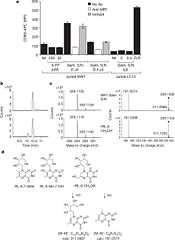User:Sruti Aiyaswamy/Sandbox 1
From Proteopedia
| Line 29: | Line 29: | ||
==MR1-restricted MAIT Activation== | ==MR1-restricted MAIT Activation== | ||
<Structure load='4DZB' size='250' frame='true' align='right' caption='MAIT Cell Receptor' scene='' /> MAIT cells compose up to 10% of the peripheral blood T-cell population in humans. They are mostly associated with mesenteric lymph nodes and the gastrointestinal mucosa.<ref>PMID:12634786</ref> They interact with the MR1-antigen complex via their αβ T-cell antigen receptor (TCR). These TCRs consist of an invariant TCR α chain coupled with a limited range of variant β chains.<ref>PMID: 22412157</ref> The MAIT TCR is restricted to MR1-antigen presentation. | <Structure load='4DZB' size='250' frame='true' align='right' caption='MAIT Cell Receptor' scene='' /> MAIT cells compose up to 10% of the peripheral blood T-cell population in humans. They are mostly associated with mesenteric lymph nodes and the gastrointestinal mucosa.<ref>PMID:12634786</ref> They interact with the MR1-antigen complex via their αβ T-cell antigen receptor (TCR). These TCRs consist of an invariant TCR α chain coupled with a limited range of variant β chains.<ref>PMID: 22412157</ref> The MAIT TCR is restricted to MR1-antigen presentation. | ||
| + | [[Image:MAIT-cell antigens.jpg|175px|left|thumb|Identification of bacterially-derived MAIT-cell antigens]] | ||
==Biological Significance== | ==Biological Significance== | ||
Revision as of 10:17, 27 November 2012
Contents |
Introduction
The MHC class I-like molecule, MR1, is an antigen presenting protein that specifically activates mucosal-associated invariant T (MAIT) cells. It has been found that microbial vitamin B metabolites serve as MR1 ligands that activate the MAIT cells.
MR1 is MHC Class I Related
|
Finally relate how MHC structure/function is similar to MR1. Explain chains, b2m, folding.
Structure of MR1-antigen Complex
| |||||||||||
MR1-restricted MAIT Activation
|
Biological Significance
There are a wide range of microbes that stimulate MAIT cells via MR1 interaction, and they all synthesize riboflavin. This suggests a possible mode by which MAIT cells might sense microbial infection or overgrowth at mucosal sites in an MR1-restricted manner.[3] There are possibly many species of bacteria in the gut flora that have riboflavin biosynthetic pathways. Perhaps the relatively frequent stimulation of MAIT cells serves as way for the body to strengthen the immune system, so as to not be overcome by the co-existing microbiota. The human microbiome is very delicately balanced. It is possible that a spiked growth of an opportunistic pathogen could trigger extensive MAIT cell activation (via MR1) to cause an effective immune response against the pathogen. There also could be other microbial-specific metabolites[4]that may serve as indicators of microbial infections that undergo immunosurveillance.
The pterin ring, an important component of MR1 ligands, occurs widely in nature and also represents a common scaffold of small molecule therapeutics.[5] Further research must be done to determine if MAIT cell-MR1 interactions are affected by drugs and diet.
References
- ↑ Treiner E, Duban L, Bahram S, Radosavljevic M, Wanner V, Tilloy F, Affaticati P, Gilfillan S, Lantz O. Selection of evolutionarily conserved mucosal-associated invariant T cells by MR1. Nature. 2003 Mar 13;422(6928):164-9. PMID:12634786 doi:10.1038/nature01433
- ↑ Reantragoon R, Kjer-Nielsen L, Patel O, Chen Z, Illing PT, Bhati M, Kostenko L, Bharadwaj M, Meehan B, Hansen TH, Godfrey DI, Rossjohn J, McCluskey J. Structural insight into MR1-mediated recognition of the mucosal associated invariant T cell receptor. J Exp Med. 2012 Mar 12. PMID:22412157 doi:10.1084/jem.20112095
- ↑ Kjer-Nielsen L, Patel O, Corbett AJ, Le Nours J, Meehan B, Liu L, Bhati M, Chen Z, Kostenko L, Reantragoon R, Williamson NA, Purcell AW, Dudek NL, McConville MJ, O'Hair RA, Khairallah GN, Godfrey DI, Fairlie DP, Rossjohn J, McCluskey J. MR1 presents microbial vitamin B metabolites to MAIT cells. Nature. 2012 Oct 10. doi: 10.1038/nature11605. PMID:23051753 doi:10.1038/nature11605
- ↑ Nicholson JK, Holmes E, Kinross J, Burcelin R, Gibson G, Jia W, Pettersson S. Host-gut microbiota metabolic interactions. Science. 2012 Jun 8;336(6086):1262-7. Epub 2012 Jun 6. PMID:22674330 doi:10.1126/science.1223813
- ↑ Kjer-Nielsen L, Patel O, Corbett AJ, Le Nours J, Meehan B, Liu L, Bhati M, Chen Z, Kostenko L, Reantragoon R, Williamson NA, Purcell AW, Dudek NL, McConville MJ, O'Hair RA, Khairallah GN, Godfrey DI, Fairlie DP, Rossjohn J, McCluskey J. MR1 presents microbial vitamin B metabolites to MAIT cells. Nature. 2012 Oct 10. doi: 10.1038/nature11605. PMID:23051753 doi:10.1038/nature11605

